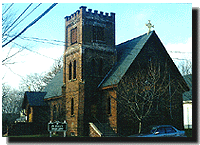
Municipalities across the Island have preserved
churches, monuments, and historic buildings that
commemorate the growth of their communities. In
recognition of their historical importance or uniqueness
of design, many of these sites have been designated
national historic sites and are adorned with plaques that
present their story. Many accomplished persons in
provincial, national, and international politics,
military service, art, education, and medicine are
honoured with memorials in communities throughout the
province.
Historic Buildings
Prince Edward Island’s Lieutenant Governor’s
residence was built in 1833–1834 by Isaac Smith,
Henry Smith, and Nathan Wright. Government House’s
neo-classical design provides an elegant setting for
formal Island gatherings and welcoming visiting
dignitaries.
Summerside’s current City Hall building was built
from 1883–1886 to serve as the town post office. The
structure was designed by Thomas Fuller, Chief Architect
of the Department of Public Works (1881–1886).
One of the finest homes built in pre-confederation
Canada, Fairholm on Fitzroy Street in Charlottetown was
constructed in 1839 for Thomas H. Haviland. It is a rare
example of early brick construction in Prince Edward
Island.
The Alberton Court House (1878) was one of six circuit
court houses built in Island communities with the passage
of the 1873 County Courts Act. Today, it houses the
Alberton Museum.
Charlottetown City Hall has the distinction of being the
oldest municipal hall in Prince Edward Island. Built in
1888, it was designed by Phillips and Chappell in the
Romanesque Revival style.
An outstanding example of residential architecture is
recognized in the Dalvay-by-the-Sea hotel in Grand
Tracadie. The structure, designed by Alexander MacDonald
of Cincinnati, was originally built as a summer house in
Queen Anne Revival Style between 1896 and 1899.
At the corner of Queen and Grafton Streets, in
Charlottetown a plaque marks the site of Hughes Drug
Store/Apothecaries Hall, which opened on Christmas Eve,
1810. The original building was replaced by the current
brick structure in 1900.

Historic Churches
Many of Prince Edward Island’s historic churches
built in the mid-to-late nineteenth century are fine
examples of High Victorian Gothic Revival. Three notable
examples, all designed by distinguished Island architect
William Critchlow Harris, Jr. are the All Souls Chapel
1884 in St. Peter’s Cathedral, the Tryon United
Church (1881), and St. Mary’s Roman Catholic Church
in Indian River.
St. Mary’s Church was completed in 1902 and was
designed in the French Gothic Style. In addition to being
the largest wood church in Prince Edward Island, it is
acoustically pure. This unique and wondrous
characteristic makes it the ideal location for the annual
Indian River Music Festival that takes place between June
and September. The church is also the frequent site of
musical recordings.
St. Andrew’s Chapel, near Mount Stewart was built in
1803. In 1864, it was transported down the frozen
Hillsborough River to become a girls’ school in
Charlottetown. It was returned to its original site in
1990 and is now being restored.
St. Dunstan’s Basilica was erected between 1897 and
1907. Consecrated and elevated to the status of basilica
in 1929, it is another spectacular example of the High
Victorian Gothic style in Canadian architecture.
For a list of historic churches follow this link.
National Park
| National Historic
Sites | Scenic Heritage
Roads |
Museums and
Historic Villages | Monuments
to Our Past
